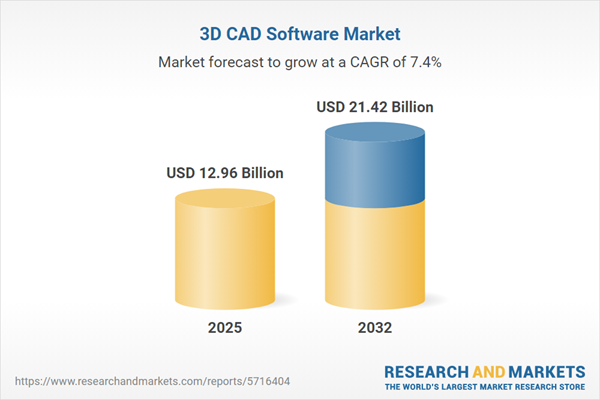Speak directly to the analyst to clarify any post sales queries you may have.
The 3D CAD software market offers organizations a powerful foundation for accelerating digital transformation, driving collaboration, and strengthening resilience in the face of ongoing industry evolution and regulatory demands. Market leaders are increasingly leveraging advanced CAD tools to streamline cross-functional processes and enable globally dispersed teams to achieve greater operational efficiency.
Market Snapshot: 3D CAD Software Market Dynamics and Opportunity
The global 3D CAD software market is experiencing consistent growth, marked by a notable compound annual growth rate (CAGR) and expanding adoption across major industries such as manufacturing, architecture, and aerospace. Cloud-enabled CAD systems are now integral to enhancing teamwork, particularly within distributed and hybrid work environments. Demand is further driven by platforms built with robust security measures and compliance management, as organizations safeguard sensitive design data while responding to evolving regulatory frameworks. Flexible deployment and cloud-based solutions support accelerated project timelines, remote operations, and sustainability targets. These dynamics position 3D CAD software as pivotal to digitalization and modernization strategies worldwide.
Scope & Segmentation of the 3D CAD Software Market
- End User Industries: Aerospace and defense organizations prioritize secure, scalable CAD tools to handle sensitive and critical data. Architecture, engineering, and construction (AEC) sectors require interoperable systems to coordinate complex, multidisciplinary collaborations. Automotive, electronics, consumer goods, medical devices, and industrial equipment industries seek solutions that address strict regulatory environments and supply chain accuracy.
- Deployment Types: Cloud-based implementations—including private, public, and hybrid models—support scalability and advanced data privacy. On-premise solutions remain relevant for organizations with specific local data protection needs or stringent compliance requirements.
- Applications: Core uses encompass advanced modeling, design simulation, validation, performance analysis, and integrated data management. These functions are essential for minimizing design risks and improving project outcomes throughout all development phases.
- Components: Enterprise-grade CAD platforms feature modular software, customizable maintenance packages, and specialized professional services. This modularity enables simplified integration and ongoing compliance support for diverse organizational structures.
- Regional Segmentation: The Americas and Europe benefit from mature digital infrastructure and high market maturity. Asia-Pacific, driven by technology adoption in China, India, Japan, and Southeast Asia, is rapidly expanding its footprint through digital transformation initiatives. In the Middle East and Africa, modernization programs facilitate diversification and infrastructure growth across industries.
- Leading Companies: Providers such as Autodesk, Dassault Systèmes, Siemens, PTC, Hexagon, Bentley Systems, Nemetschek, Trimble, ANSYS, and 3D Systems deliver sector-focused CAD platforms, continually aligning product features to evolving enterprise needs and regulatory conditions.
3D CAD Software Market: Key Takeaways for Senior Decision-Makers
- Unified CAD platforms enable comprehensive collaboration by connecting design, engineering, and management teams during every stage of the product lifecycle.
- Integrated generative design and simulation functions support streamlined development processes and foster rapid response to evolving project requirements.
- Cloud-native and hybrid deployment options build cohesion among dispersed teams and help organizations uphold compliance in diverse regulatory settings.
- Flexible system architectures offer tailored solutions for industries with stringent regulations or complex, sector-specific design workflows.
- Automated compliance capabilities at the regional level increase adaptability and ease management of cross-border regulations in dynamic trade environments.
- Open integration and broad ecosystem compatibility simplify alignment with enterprise systems, supporting scalable growth as organizations move toward digital maturity.
Tariff Impact on 3D CAD Software Procurement and Deployment
Recent tariff changes in the United States are reshaping how enterprises approach procurement and deployment of 3D CAD software. Rising tariffs affecting electronics and design-related inputs are prompting companies to revisit their procurement models and supply chain structures. The emphasis is now on modular, configurable solutions and enhanced supply resilience. Nearshoring tactics are gaining adoption to maintain steady supply and control over delivery timelines. Cloud-based CAD platforms provide flexibility and help organizations maintain regulatory compliance for distributed teams, making close coordination between procurement and engineering crucial to reduce risks and ensure operational continuity.
3D CAD Software Market Research Methodology & Data Sources
This analysis draws on structured executive interviews, in-depth reviews of technical documentation and regulatory materials, and evaluations of corporate disclosures. Scenario modeling and capability benchmarking are used to develop insights relevant for technology investment decisions.
Why This Report Matters: Actionable Insights for Leadership
- Equips leadership to align 3D CAD software strategies with evolving compliance and supply chain demands.
- Provides practical benchmarks for selecting digital platforms based on operational and growth priorities.
- Guides managers and technical teams in expediting digital design adoption while integrating compliance throughout design workflows for improved outcomes.
Conclusion
Choosing the right 3D CAD software empowers organizations to adapt quickly to shifting industry and regulatory landscapes. This approach fosters innovation, operational advancement, and supports sustainable long-term business goals.
Additional Product Information:
- Purchase of this report includes 1 year online access with quarterly updates.
- This report can be updated on request. Please contact our Customer Experience team using the Ask a Question widget on our website.
Table of Contents
3. Executive Summary
4. Market Overview
7. Cumulative Impact of Artificial Intelligence 2025
Companies Mentioned
The companies profiled in this 3D CAD Software market report include:- Autodesk, Inc.
- Dassault Systèmes SE
- Siemens AG
- PTC Inc.
- Hexagon AB
- Bentley Systems, Incorporated
- Nemetschek SE
- Trimble Inc.
- ANSYS, Inc.
- 3D Systems Corporation
Table Information
| Report Attribute | Details |
|---|---|
| No. of Pages | 185 |
| Published | November 2025 |
| Forecast Period | 2025 - 2032 |
| Estimated Market Value ( USD | $ 12.96 Billion |
| Forecasted Market Value ( USD | $ 21.42 Billion |
| Compound Annual Growth Rate | 7.4% |
| Regions Covered | Global |
| No. of Companies Mentioned | 11 |









